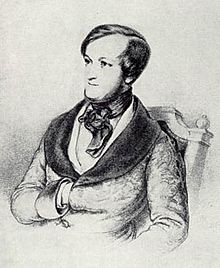The Flying Dutchman facts for kids
Quick facts for kids The Flying Dutchman |
|
|---|---|
| by Richard Wagner | |

Wagner, ca. 1840
|
|
| Genre | Opera in 3 acts |
| Native title | Der fliegende Holländer |
| Librettist | Richard Wagner |
| Language | German |
| Based on | Legend |
| Premiere | Semper Oper, Dresden, Germany 1843 |
Der fliegende Holländer (which means The Flying Dutchman) is a famous opera by Richard Wagner. An opera is like a play where the story is told mostly through singing, with music played by an orchestra. Wagner wrote both the music and the story (called the libretto) for this opera himself.
The story is based on an old legend about a ship captain. This captain is cursed to sail the seas forever, never being able to step on land. He can only be saved if he finds true love. This idea of being saved by love was very important to Wagner, and he used it in many of his later operas too.
Contents
The Story of The Flying Dutchman Opera
The opera tells the tale of the Dutchman, a captain cursed to sail the seas until he finds a woman who will love him truly and be faithful to him. He is allowed to come ashore only once every seven years to search for this love.
One day, he meets Senta, a young woman who is fascinated by the legend of the Flying Dutchman. She feels a deep connection to him and believes she can be the one to free him from his curse. Their love story unfolds, leading to a dramatic ending where Senta's loyalty is tested.
Who Was Richard Wagner?
Richard Wagner was a very important German composer. He lived from 1813 to 1883. He is famous for his operas, which he called "music dramas." Wagner wanted the music, story, and stage design to all work together perfectly to tell a powerful story.
Der fliegende Holländer was one of Wagner's earlier operas. He first showed it to the public in Dresden, Germany, in 1843. Even though it was an early work, it already showed many of the special things that would make Wagner's music unique later on.
The Music of the Opera
The music in Der fliegende Holländer is very dramatic and exciting. Wagner used special musical ideas called leitmotifs. A leitmotif is a short musical tune or phrase that is linked to a specific character, place, or idea in the story.
For example, in this opera, you'll hear a leitmotif for the powerful ocean, one for the mysterious Dutchman, and another for Senta. These musical ideas help tell the story and show what the characters are feeling. You can hear many of these important leitmotifs right at the beginning of the opera, in the music called the overture.
How It's Performed
When Wagner first wrote Der fliegende Holländer, he wanted it to be played without any breaks between the acts. This means the music would flow continuously from beginning to end, making the story feel even more intense.
Sometimes, operas are performed this way today. However, Wagner also made another version of the opera that has three separate acts, with short breaks in between. This is how it is often performed in opera houses around the world.
Images for kids
-
View of Table Bay (near Cape Town, Dutch Cape Colony) with ships of the Dutch East India Company, around 1683.
-
Replica of an East Indiaman ship. The legend of the Flying Dutchman likely started during the 1600s, when the Dutch East India Company was very active.
-
An old picture showing a scene from Richard Wagner's opera Der fliegende Holländer.
-
KLM airlines using the slogan "The Flying Dutchman."
-
A book picture showing a mirage of two boats.
See also
 In Spanish: El holandés errante (leyenda) para niños
In Spanish: El holandés errante (leyenda) para niños








